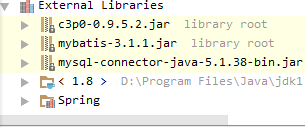Java数据库连接(JDBC)、JDBC连接池(c3p0)、MyBatis分别如何使用?如何连接数据库?
一、JDBC的使用
第一步:导入jar包(mysql-connector-java.jar)
第二步:jdbc就是一个连接数据库工具,分为几个步骤
- 加载驱动
- 创建连接
- 创建statement
- 执行语句
第三步:编写代码实现
public class JdbcTest { public static void main(String[] args) throws ClassNotFoundException, SQLException { Class.forName("com.mysql.jdbc.Driver"); String url = "jdbc:mysql://localhost:3306/book"; String user = "root"; String password = "123456"; Connection connection = DriverManager.getConnection(url, user, password); Statement statement = connection.createStatement(); String sql = "select * from book_info where book_id=1"; ResultSet result = statement.executeQuery(sql); while(result.next()) { System.out.println(result.getString(1) +" "+result.getString(2) +" "+result.getString(3) +" "+result.getString(4) +" "+result.getString(5) +" "+result.getString(6) +" "+result.getString(7) +" "+result.getString(8) +" "+result.getString(9) +" "+result.getString(10) +" "+result.getString(11) ); } result.close(); statement.close(); }
二、c3p0的使用
第一步:导入jar包mysql-connector-java.jar和c3p0.jar
第二步:参数配置
<?xml version="1.0" encoding="UTF-8"?>
<c3p0-config>
<default-config>
<property name="user">root</property>
<property name="password">123456</property>
<property name="jdbcUrl">jdbc:mysql://localhost:3306/book</property>
<property name="driverClass">com.mysql.jdbc.Driver</property>
</default-config>
</c3p0-config>
第三步:编写代码实现
package com.xc.c3p0; import java.sql.Connection; import java.sql.ResultSet; import java.sql.SQLException; import java.sql.Statement; import javax.sql.DataSource; import com.mchange.v2.c3p0.ComboPooledDataSource; public class C3p0 { public static void main(String[] args) throws SQLException { DataSource source = new ComboPooledDataSource(); Connection connection = source.getConnection(); Statement statement = connection.createStatement(); String sql = "select * from book_info"; ResultSet result = statement.executeQuery(sql); while(result.next()) { System.out.println(result.getString(1) +" "+result.getString(2) +" "+result.getString(3) +" "+result.getString(4) +" "+result.getString(5) +" "+result.getString(6) +" "+result.getString(7) +" "+result.getString(8) +" "+result.getString(9) +" "+result.getString(10) +" "+result.getString(11) ); } result.close(); statement.close(); } }
三、MyBatis的使用
注:此处不在详细讲解操作步骤,而是主要整理技术演进,详细操作流程请参考其他博主的教程
第一步:项目中需要导入下图中三个jar包

第二步:编写配置文件以及测试代码
1、db.properties
driver=com.mysql.jdbc.Driver url=jdbc:mysql://localhost:3306/book username=root password=123456
2、mybatis-config.xml
"<configuration> <properties resource=""db.properties""/> <environments default=""development""> <environment id=""development""> <transactionManager type=""JDBC""></transactionManager> <dataSource type=""POOLED""> <property name=""driver"" value=""${driver}""></property> <property name=""url"" value=""${url}""></property> <property name=""username"" value=""${username}""></property> <property name=""password"" value=""${password}""></property> </dataSource> </environment> </environments> <mappers> <mapper resource = ""com/xc/dao/impl/UserMapper.xml""></mapper> </mappers> </configuration> "
3、UserMapper.xml
"<mapper namespace=""com.xc.dao.impl.UserMapper""> <select id=""count"" resultType=""int""> select count(1) as count from users </select> </mapper> "
4、UserMapperTest.java
public class UserMapperTest {
public static void main(String[] args) throws SQLException, FileNotFoundException {
String resource = "D:\\Eclipse_WorkSpace\\MavenProject\\WebMavenDemo01\\src\\main\\resources\\mybatis-config.xml";
InputStream in = new FileInputStream(resource);
SqlSessionFactory factory = new SqlSessionFactoryBuilder().build(in);
int count = 0;
SqlSession sqlSession = null;
sqlSession = factory.openSession();
//执行sql
count = sqlSession.selectOne("com.xc.dao.impl.UserMapper.count");
System.out.println(count);
sqlSession.close();
}
}
四、总结
MyBatis 是一款优秀的持久层框架,它支持定制化 SQL、存储过程以及高级映射。MyBatis 避免了几乎所有的 JDBC 代码和手动设置参数以及获取结果集。MyBatis 可以使用简单的 XML 或注解来配置和映射原生信息,将接口和 Java 的 POJOs(Plain Old Java Objects,普通的 Java对象)映射成数据库中的记录。



